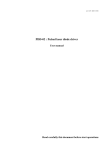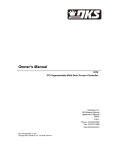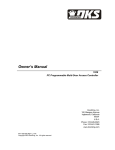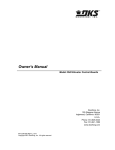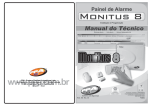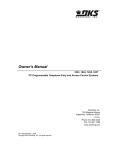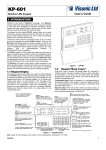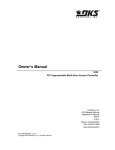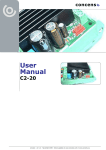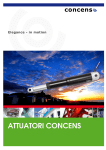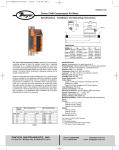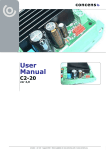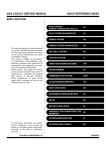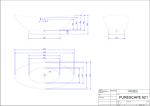Download Manual C3CON1X
Transcript
User Manual C3CON1X One-channel Control Box concens control concept Version 1.2 – December 2011 Installation The one-channel C3CON1X control box with wired hand control and rechargeable NiMH battery from concens is a control circuit with many features, which is recommended when controlling an ac-tuator with DC motor. The system normally consists of: 1.1) Controlbox (picture 1) with: ●● 2 pcs 6-pole connectors for motor and handset. ●● 1 connector for the Patented 1400mAh NiMH ●● Rechargeable NiMH battery 24VDC, 1400mAh (picture 6) 1.2) Handset (picture 2) with 2 buttons and spiral cable. The control box is mounted by using the U-shaped safety clip (item 1.5) delivered with the system (pat. Appl). The bracket is made of steel, and can be welded onto the wanted location, or mounted by using the holes in the bracket. The controlbox (item 1.1) is hold in the bracket by the strong neodymium magnets inside the box. If the controlbox is to be mounted in a direction where there is a risk for falling off during mowing, then a springloaded safety clip (picture 5) is available (optional). The actuator and handset must be installed by using the 6-pole (Molex Minifit size 5556) connectors mounted side by side. They are both wired equal enabling flexibility in selecting the wanted connector. 1 2 3 1.3) Charger (picture 3) 100-240VAC 1.4) Bracket (picture 4) for mounting C3 controlbox. 4 1.5) Safety clip (picture 5). To be used if controlbox is mounted vertical or upside down, or if strong fixation is needed. Optional. 5 6 The handset (item 1.2) can be delivered with a hook (picture 7) or with a flat backside (picture 8). The flat backside make the use of wall holder available (picture 9) by utilizing the build-in neodymium magnets in the handset (pat. Appl). Also a string can be used for holding the handset (picture 10). 7 8 9 Version 1.2 – December 2011 2 The manufacturer of this equipment is not aware of any harmful interference caused by this equipment to other equipment. However, there is no guarantee that interference will not occur in particular installations and it is recommended to test the equipment in the actual environment prior to putting it into use. 10 Operation Startup The system is started by inserting the battery into the circular holder in the end of the controlbox (picture 11). Since the battery is hold by eight strong neodymium magnets (pat. Appl) , it will hold itself in place with the correct position (picture 12), and a confirming BEEEEEEP is heard. This indicates, that the connection is made, the voltage level is accepted, and the system can be used. When one of the buttons on the handset is pressed (picture 13), then the actuator starts and is mowing until the button is released again, or if the actuator has reached the end of the stroke, whereby the DC motor stalls which will let the control circuit disconnect the voltage to the motor, and switch on the braking system to hold the actuator from mowing. Features The same will happen if the actuator meets a resistance for mowing. The controlbox can be programmed to have “soft-start” of the actuator, which is always recommended, since it gives a more smooth movement, and this way of starting a DC motor is avoiding the big start current which is normal without “soft-start”. “Soft-start” results in longer lifetime of the motor. The controlbox is programmed to control and protect the actuator. It can be set to control 0-4 Ampere, or max 10 Ampere by internal switch. The controlbox checks the battery level every 24 seconds, and when the battery reaches a low limit, then the controlbox will give a double-beep every 24 seconds to indicate that the battery needs recharging. The battery voltage level is also checked every time the actuator is used, and if the Voltage level is under the pre-programmed level, then the controlbox gives a doublebeep thereby indicating the need for a re-commended recharge of the battery, or exchange to another recharged battery. Battery The battery is protected inside with a thermostat which will disconnect the connection to the outside when the inside temperature has reached 55ºC. This will prevent a shortcircuit or too heavy use, from damaging the battery. The 2 poles on the end of the battery are the negative voltage connection, and the connector in the centre of the end of the battery is the positive connection. Handling of batteries Insert battery: Clean the magnetic poles for all dirt or metal chips. Push the battery into the C3 housing, turn it right or left until it is being pulled into the right position by the magnets in the end of that battery. The C3-controller is confirming connection with a BEEEEEEEEP. Remove battery: Turn the battery 90 degrees (right- or left) - the battery will be ”pushed out” due to the magnets at the top end of the battery. Keep the battery poles free of dirt and metal chips. Charging battery: Shall be done in the ”C3-charger”, full re-charging takes 5-8 hours, depending on state of charge. The battery (NiMH-type) can be recharged from any state of charge without reducing battery life or battery-capacity. When connecting the ”C3-charger” to the mains (100 – 240 V AC), the red diode lights up continuously and a single flash in the green diode appear before it turns off again. When inserting the battery into the charger, the green diode starts flashing with an interval of 1/sec during the charging process. When charging is finishing, the green diode stops flashing and turns on continuously, the battery is fully charged, can be removed and is ready for use in the C3 controller. Repeated runs at a high rate with heavy loads, may create overheating inside the battery – a safety interlocktemperature sensor will disconnect the power. When the battery has cooled down to accepted working temperature the power switch on automatically. The battery ”is pulled-into” the C3housing by heavy magnets. Take care with dirt, such as metallic particles and other small magnetic parts ! – in serious cases it may prevent electrical contact and the C3-controller / C3 charger shall to be returned for repair. Always - check for dirt on the battery poles before inserting it into the C3-controller ! Batteries not used: To secure long lifetime of NiMH batteries, we recommend to recharge the battery at least every 3 months. Do not dispose batteries in the ordinary household waste. Some communities offer recycling or collection of batteries — contact your local government for disposal practices in your area. 11 12 13 Beep signals: BEEEEEEEP: Power on (battery inserted) BEEP..BEEP: Every 24 seconds (when the system is not in use): = indicating low battery level, please recharge. BEEP..BEEP: When starting the actuator = low voltage, please change battery soon, or recharge—the battery will still give power, but only limited time. BEEEEEEEP: When running the actuator = battery lower than 17,6Volt (only down/in movement will be accepted thereafter) BEEP..BEEP..BEEP..BEEP (Temperature inside control box too high, please take a break) Version 1.2 – December 2011 3 Specifications C3 System Components 1. Control box (491 grams) 2. Hand control (93 grams) Standard cable length 75 cm (200 cm stretched) 3. Battery charger box (500 grams) 4. Bracket (318 grams) 5. Battery (573 grams) 1 2 Black (RAL 9005) is standard colour and beige (Pantone 454) foil on remote control 3 Foil design can be adapted to customer requirements. Fuse: T 5A located inside connector end. To be exchanged using T10 screwdriver. Dimensions Type Power supply Maximum continuous current Capacity Low-capacity warning NiMH 24 V DC 7 A (Short-time peak current 10 - 20 A) 1400 mAh Sound signal 54.5 40 156.2 7 5 91.5 Battery Ø51.8 Battery 4 3.5 123 40 Battery Attention, consult 45 Ø51.8 142 Hand control ACCOMPANYING DOCUMENTS - If faults are observed, the product must be replaced or returned to manufacturer for repair. - If the C3 controller for some reason is not being used for a few days remove battery from the C3 controller to protect the battery against deep discharge and permanent damage. - Cleaning of product can be done using a damp cloth. Version 1.2 – December 2011 4




